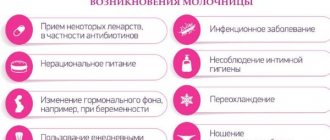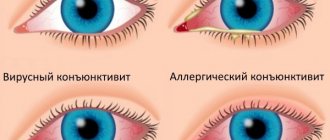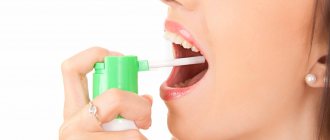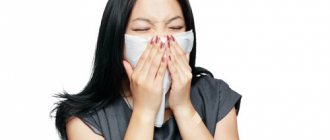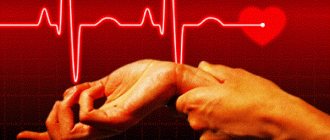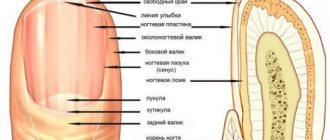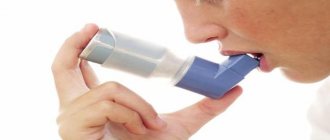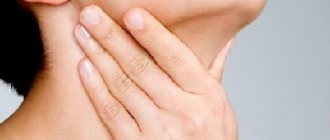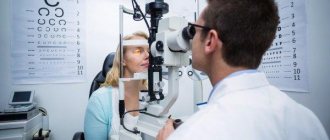Causes
Overheating of the body in most of the population causes profuse sweating, and this provokes prickly heat. A rash can occur under the influence of unfavorable factors:
- severe stress and nervous shock;
- staying in a humid and hot climate;
- intense exercise (one of the causes of heat rash in adolescence);
- the use of deodorants, creams and other products that prevent skin breathing;
- diseases of the nervous system;
- pathologies of the endocrine system, hormonal imbalances;
- neglect of personal hygiene rules;
- excess body weight.
Expert opinion
Sakania Luiza Ruslanovna
Dermatovenerologist, cosmetologist, trichologist
Ask a Question
Often, a rash appears during illnesses that increase the temperature: influenza or ARVI. Cosmetics, clothing or shoes that are inappropriate for the weather (especially hats in the hot season), and prolonged exposure to the sun can cause the disease.
Which doctor should I contact?
You cannot start therapy on your own, otherwise complications will not be avoided. If the disease is accompanied by itching, make an appointment with a dermatologist. If there is a rash without discomfort, it is better to visit a therapist. In cases where the disease is caused by pathologies of internal organs, you will have to visit a highly specialized specialist, for example, an endocrinologist.
ICD-10 code
In the international classification of diseases, prickly heat in adults is recorded under code L74 Diseases of the merocrine [eccrine] sweat glands.
Treatment methods
To get rid of prickly heat, it is customary to use folk recipes and pharmaceutical preparations. However, they can only help at the initial stage of the disease. In advanced cases, surgical intervention is required, so do not delay your visit to the doctor.
Folk remedies
Before experimenting with alternative medicine, consult your doctor. Under no circumstances choose recipes that contain aggressive ingredients: alcohol or poisonous plants. The dermis with prickly heat is already irritated; alcohol-containing medications will cause severe pain.
Give preference to herbal-based medicines: lotions, compresses and decoctions. Chamomile, calendula, sage, yarrow, and oak bark have a good effect. While showering, rinse your body with soda solution and use laundry soap.
Ointments and creams
Be sure to prescribe creams and ointments that dry out the rash and reduce itching. Several effective remedies from different groups can be seen in the table.
| Effect of the drug | Name | Duration of use | Contraindications |
| Anti-inflammatory and drying ointments | Calamine | Several times a day for 7-10 days | Individual intolerance to zinc |
| Anti-inflammatory and drying ointments | Tsindol | From 3 to 5 times a day, the duration of the course depends on the severity of the disease | Hypersensitivity to zinc |
| Anti-inflammatory and drying ointments | Zinc ointment | 5-6 times a day until the symptoms of prickly heat disappear | Doesn't exist other than zinc allergy |
| Anti-inflammatory and drying ointments | Desitin | Use as needed (usually 3-5 times daily) until irritation heals | Intolerance to any of the components of the drug |
| Products with Dexapanthenol | Bepanten | Several times a day until recovery and for some time after | Allergic reaction to substances included in the product |
| Products with Dexapanthenol | Pantoderm | Rub into affected areas 1-3 times a day until improvement | Component intolerance |
| Antibiotic medications | Tetracycline | Use as a bandage 1-2 times a day for 2-3 weeks. Change the dressing every 12 hours | Fungal infection of the skin, allergies to the components of the product, heart and kidney diseases |
| Antibiotic medications | Levomekol | Treat diseased areas 2-3 times until healing | Presence of allergy to one of the components, children under 6 years of age |
| Antibiotic medications | Ichthyol ointment | Up to 3 times a day in the form of a compress, duration of therapy - 2-3 weeks | Under 6 years of age and substance intolerances |
| Antihistamines | Gistan | Once a day until the disease subsides | Heart pathologies, hypersensitivity to the substance, children under 1 year of age |
| Antihistamines | Fenistil | No more than 4 times a day for two weeks | Allergic reaction to dimethindene. Cannot be used to treat infants under 1 month of age |
When treating severe heat rash, hormonal ointments are prescribed: Dermaveit or Afloderm. Do not use them yourself as they cause side effects. Plus, they cannot be used for a long time; the course lasts from 7 to 14 days.
Powders
It is recommended to powder the folds of the skin with powder, which absorbs excess sweat and prevents prickly heat. At the pharmacy you can buy Baneocin, baby powder or talc. In addition to them, corn or potato starch is sometimes used. Apply the powder after shower to dry skin, paying attention to the armpits, genitals, and legs.
Antiseptics
Sweat is an ideal breeding ground for pathogenic microorganisms that can cause infection. They will be destroyed by antiseptic solutions that are used to treat the dermis in areas of prickly heat. Salicylic and boric acid, as well as a weak solution of potassium permanganate, are suitable.
Oral antibiotics
In case of secondary infection, the use of antibiotics is required. Often external use does not bring results, so the doctor decides to prescribe drugs for oral administration: Doxycycline, Amoxilicin, Ciprofloxacin.
Phytotherapy
Products based on herbal ingredients have an antiseptic effect and are excellent at drying out eczema on the skin. Infusions of medicinal herbs can be used in the form of baths, lotions and solutions for wiping. Usually, 2-3 tablespoons of raw material are taken per liter of water, infused for several hours and used to treat damaged areas. The rash can be lubricated with essential oils, the action of which is aimed at regenerating the epidermis.
Advice from Dr. Komarovsky
One of the most famous children's doctors, Evgeny Komarovsky, has his own opinion about prickly heat in newborns and older children. He argues that rashes are not a cause, but primarily a consequence of any ailment. Therefore, at the first signs of miliaria, it is recommended to immediately determine what could be the source, whether it is dangerous or insignificant for the baby.
There can be a huge number of reasons for the formation of local or widespread prickly heat - from the most common to the rare. For example, diathesis, diabetes mellitus, cuts, bruises and other mechanical damage, allergic reactions, excess weight. Often this disease plagues premature babies, and can also be a concomitant pathology with various infectious diseases: chickenpox, tonsillitis, measles, rubella, pneumonia. But the heat rash is never passed from child to child.
If the causes cannot be identified, and apart from pimples, there are no obvious symptoms, and the child behaves the same as before the rash, then you should pay attention to food, clothing or insect bites that could provoke an allergic reaction.
The doctor classifies miliaria as one of the popular diseases of young children of the 21st century, which appears in the hot summer or any other season of the year in a stuffy room with high humidity. Small pimples with liquid first appear on the neck, and then spread to the chest, back, cheeks and behind the ears.
The doctor claims that the mother and only the mother, being with the baby 24 hours a day, can accurately determine what caused the rash and correctly analyze the situation.
For example, he advises taking a glass of clean boiled water and dissolving one teaspoon of soda in it. A cotton pad soaked in this solution should be used to soak the affected areas every two to three hours. Under no circumstances should you vigorously rub the product on your baby’s skin. This will only worsen the situation and prolong the illness.
Baby powder should always be in a new mother's arsenal. After all, this remedy protects the baby from irritation, inflammation and bacteria during heat rash. The powder removes excess liquid and dries out delicate skin. But it should be remembered that the powder can be used only after the child reaches one month of age.
If you don’t have powder on hand, you can temporarily use regular potato starch with the addition of various soothing herbs.
In hot weather and heat, it is necessary to remove diapers, diapers and clothes at least temporarily. In this way, the baby’s skin will be saturated with oxygen and the body will be hardened.
Dr. Komarovsky talks about the safety of the disease, but he also strongly recommends remembering the consequences of sweating sickness if you accidentally become infected. Ordinary pimples with liquid go away in two to three days, but if the baby’s immunity is weakened, then minor rashes can develop into serious diseases.
To learn how to get rid of heat rash in newborns, watch the following video.
Types and signs
Before starting treatment, familiarize yourself with the types of pathology. There are papular, crystalline and red heat. A description of each type and symptoms will help you independently identify the cause of the discomfort, but remember that only a specialist can make a final diagnosis.
Papular disease
Often, papular miliaria forms in the summer, when it is hot outside and has high humidity. The rashes look like small blisters (up to 1-2 mm in diameter) flesh-colored. Cover arms and legs, chest, stomach. The skin is very flaky and itchy, which causes discomfort to the person.
Red type disease
As with the previous form, the bubbles are small in size (up to 2 mm). It is worth noting that there is liquid inside, and the rash has clear boundaries. It does not merge into large plaques, it itches terribly and causes an increase in body temperature. Itching worsens with sweating or at night. Localization of the disease is the inner thighs, genitals, mammary glands.
Miliaria apocrine
This type is caused by disturbances in the functioning of the apocrine glands located in the armpits, genitals and nipples. The rashes are red and painful as they affect the deeper layers of the skin.
Crystal prickly heat
As a rule, babies suffer from crystalline prickly heat. Small bubbles are white, but more often they are transparent and merge into large plaques. Cover the back, chest, stomach, neck. They itch very much, over time they burst, fall asleep and become crusty. In addition, they provoke swelling of the skin.
Miliaria alba
Another type diagnosed mainly in children. Appears due to the penetration of pyogenic microflora into the thickness of the dermis. Blisters form on the skin, containing white or gray liquid. The causative agent of the disease is staphylococcus, which can leave scars and depigmentation in the absence of therapy.
Miliaria profuse
Experts call this type a complication of prickly heat and is considered the most severe. The reasons for the development are climate change or intolerance to weather conditions. Itchy vesicles appear on the body, the person suffers from soreness of the skin, swelling, redness and increased body temperature.
Infected heat rash
Substances harmful to the body are removed with sweat, which causes skin irritation and inflammation in the absence of hygiene. As a result, natural protection is reduced, and bacteria and pathogenic microorganisms penetrate through the epidermis. In all cases, there is liquid inside the blisters, and the rash itches and causes swelling of the dermis.
Be sure to seek help from a doctor. At first glance, diagnosing prickly heat on your own is not difficult, but similar symptoms (itchy spots, pustules, fever) hide a more dangerous infectious disease. Common ones include chickenpox, herpes, measles, and scarlet fever.
Where is prickly heat most often located?
The occurrence of symptoms of the disease in certain areas of the skin is associated with the class of the disease.
With crystalline prickly heat, rashes can appear on any part of the body, however, the face and extensor surfaces of the limbs are most susceptible to it.
Miliaria rubra is characterized by localization of the rash on the abdomen, elbows and forearms. The skin between the buttocks and in the armpits is affected. In obese women, this type may appear in the groin and under the breasts.
Papular miliaria manifests itself on the limbs, abdomen and sides.
Elimination of excessive sweating
The main cause of prickly heat and irritation on the epidermis is excessive sweating. Antiperspirants, personal hygiene, ointments and creams will help you cope with it.
In some cases, experts recommend botulinum toxin injections, which block the nerve endings responsible for sweat production. The effect lasts up to 12 months. There are also preparations based on formalin and tannin that have a similar effect. A safer method to get rid of excessive sweating is laser and microcurrent therapy.
Prevention
Every person needs to know about measures to prevent heat rash. They will help avoid not only the appearance of wet circles on clothes, but also an itchy rash on the body. Try to follow the following rules:
- stick to proper nutrition to stay at a comfortable weight;
- wear clothes exclusively made from natural fabrics; in summer, give preference to light-colored cotton items;
- avoid intense physical activity;
- do not forget about water procedures twice a day; in the hot season, treat sweating areas several times a day;
- reduce the use of cosmetics to a minimum;
- spend as little time in the sun as possible or protect your skin from UV rays;
- Keep your nails short so as not to scratch prickly heat rashes until they bleed and cause infection.
Expert opinion
Sakania Luiza Ruslanovna
Dermatovenerologist, cosmetologist, trichologist
Ask a Question
First of all, pay attention to the condition of the body. If there are hormonal disorders or pathologies of internal organs, then the problem of excessive sweating will progress.
Possible complications, what are the dangers
In some cases, when prickly heat appears, there are no aggravating factors other than rashes. Such prickly heat will not have complications, and treatment takes place in a short time.
If, in addition to the rash, swelling, itching, and soreness appear on the affected areas of the skin, and the liquid in the blisters is cloudy or yellowish, there is a possibility that the disease is progressing. Or, in addition to prickly heat, there may be a bacterial infection.
